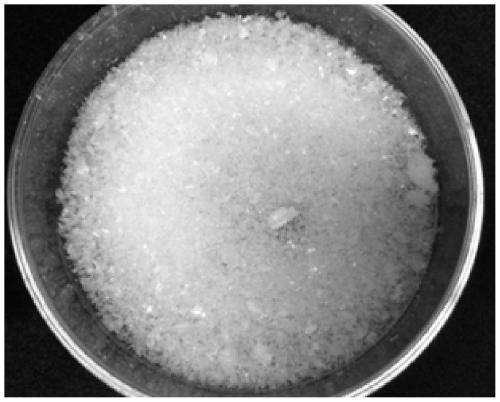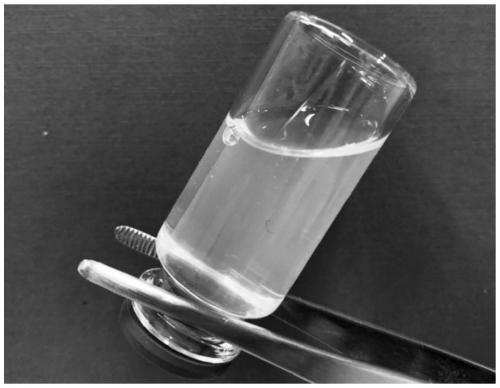Polymer compound capable of being quickly dissolved or dispersed in water-containing solvent as well as preparation method and application of polymer compound
A polymer and composite technology, applied in the field of medical polymers, can solve the problems of easy mutual adhesion, loss of rapid dissolution, increase in use cost, etc., to achieve the effect of convenient use and improvement of entanglement
- Summary
- Abstract
- Description
- Claims
- Application Information
AI Technical Summary
Problems solved by technology
Method used
Image
Examples
Embodiment 1
[0041] A polymer complex 80P20CaCl that dissolves rapidly in aqueous solvents 2 , which consists of 1.6g of PLA-PEG-PLA with a molecular weight of 1750-1500-1750 and 0.4g of calcium chloride.
[0042] Step (1): 1.6 g of PLA-PEG-PLA with a molecular weight of 1750-1500-1750 was placed in water, and magnetically stirred at 4°C for 24 hours to form a solution with a polymer concentration of 20 wt %;
[0043] Step (2): Dissolving 0.4g of calcium chloride in water to form a calcium chloride solution;
[0044] Step (3): Add the calcium chloride solution in step (2) to the polymer solution in step (1), dilute with water until the polymer concentration is 15wt%, mix well and put it in a water bath at 37°C for 2 hours to form gel;
[0045] Step (4): The gel obtained in step (3) was frozen at -80° C. for 4 hours, then vacuum-dried in a freeze dryer for 12 hours to obtain a polymer complex that quickly dissolved in an aqueous solvent.
[0046] The characteristics of polymer complexes ...
Embodiment 2
[0048] A complex of polymers 90P10CaCl that dissolves rapidly in aqueous solvents 2 -1, which consists of 0.9g of PLGA-PEG-PLGA with a molecular weight of 1500-1000-1500, 0.9g of PLGA-PEG-PLGA with a molecular weight of 1250-1500-1250, and 0.2g of calcium chloride.
[0049] Step (1): 0.9 g of block copolymers with two molecular weights were placed in water together, and magnetically stirred for 24 hours at 4° C. to form a solution with a polymer concentration of 20 wt %;
[0050] Step (2): Dissolving 0.2g of calcium chloride in water to form a calcium chloride solution;
[0051] Step (3): Add the calcium chloride solution in step (2) to the polymer solution in step (1), dilute with water until the polymer concentration is 4.5wt%, place it at 20°C and stir for 0.5h, then stir while stirring Raise the temperature to 40°C, and continue to stir for 0.5h to obtain a compound solution;
[0052] Step (4): The solution obtained in step (3) was frozen at -20°C for 12 hours, and then ...
Embodiment 3
[0055] Polymer Complex 90P10CaCl Dissolves Rapidly in Aqueous Solvents 2 -2, its composition is 1.8g of PLGA-PEG-PLGA with a molecular weight of 1950-1500-1950, and 0.2g of calcium chloride.
[0056] Step (1): 1.8 g of PLGA-PEG-PLGA with a molecular weight of 1950-1500-1950 was placed in water, and magnetically stirred at 4° C. for 24 hours to form a solution with a polymer concentration of 20 wt %;
[0057] Step (2): Dissolving 0.2g of calcium chloride in water to form a calcium chloride solution;
[0058] Step (3): Add the calcium chloride solution in step (2) to the polymer solution in step (1), dilute with water until the polymer concentration is 10wt%, place at 20°C and stir for 0.5h, then heat up while stirring to 40°C, continue to stir for 0.5h to obtain a compound solution;
[0059] Step (4): The solution obtained in step (3) was frozen at -20° C. for 12 hours, then vacuum-dried in a freeze dryer for 24 hours to obtain a complex that quickly dissolved in an aqueous s...
PUM
 Login to View More
Login to View More Abstract
Description
Claims
Application Information
 Login to View More
Login to View More - R&D Engineer
- R&D Manager
- IP Professional
- Industry Leading Data Capabilities
- Powerful AI technology
- Patent DNA Extraction
Browse by: Latest US Patents, China's latest patents, Technical Efficacy Thesaurus, Application Domain, Technology Topic, Popular Technical Reports.
© 2024 PatSnap. All rights reserved.Legal|Privacy policy|Modern Slavery Act Transparency Statement|Sitemap|About US| Contact US: help@patsnap.com










